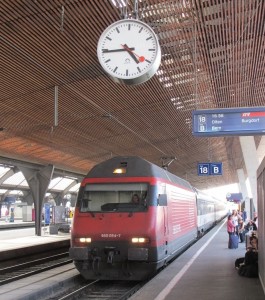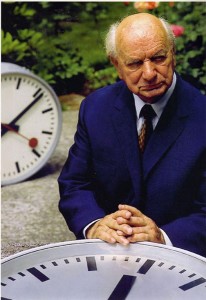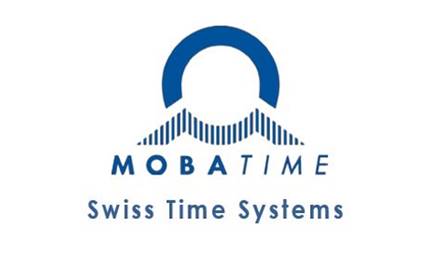Why is the Swiss Railways clock design so special?
Here at LUMICHRON, custom clock faces/dials are a big deal. We work with numerous designs, all carefully selected to meet our customers’ needs. With so many options, one may wonder, why do we choose to use the Swiss Railways custom clock face design on our home page? What makes this particular dial so special?
The Swiss Railway clocks are produced by MOBATIME, a subsidiary of the Swiss company Moser-Baer. LUMICHRON is MOBATIME’s US partner, and we embrace that famous Swiss penchant for punctuality and technical expertise. We view the clean, timeless design of the Swiss dial as a symbol, a model for how we approach our work: Clean, exacting, progressive, and modern. In fact, we have a working system identical to what is found in every station in Switzerland in our workshop (though unfortunately we don’t have any trains)! The Swiss dial has an interesting story behind it as well.
The Swiss Railway dial as we know it today was developed by Hans Hilfiker (1901-1993) in 1944, as an attempt to meet the diverse needs of the modern railway station. Perhaps he was destined to create what would become the icon of the Swiss Railway, being born just months before the country’s railway system formally became a federal institution on January 1, 1902.
If you ride a train in Switzerland today, you may see SBB CFF FFS emblazoned on the side of the trains and wonder what those letters mean. They are each an abbreviation for ‘Swiss Federal Railway’ in the three official languages of Switzerland- German, French, and Italian. Thankfully, any one of the three will do, and the abbreviations are much quicker to read than Schweizerische Bundesbahn, Chemins de fer fédéraux Suisse or Ferrovie federali svizzere. Like Europe in miniature, the country is an amalgam of language and culture, woven together with a network of railways, all keeping time to one symbol- the Swiss Railway clock.
The dial is easily recognizable- plain black tick marks, accented on the hour, matching black hands to denote the hour and minute, and the unique red disc second hand, or ‘sweep’- all perfectly proportioned. Very recently it was chosen by the London Design Museum and the Museum of Modern Art as “one of the most iconic examples of 20th century design.” With the exception of adding the red sweep in 1953, which is based on the hand-held signal baton once used to prepare trains for departure, the Swiss Railway clock remains quite unchanged from its original form. It is an enduring representation of pragmatic simplicity. Such is the continuing influence of the clock and its designer that the SBB corporate headquarters is located on Hilfiker Street!
Prior to 1953, railway station clocks displayed time accurate only up to the minute, which, as Hilfiker put it, is simply too long. This deficiency could leave people scrambling to board at the last second; unaware of exactly how much time was available before departure. The remedy for this problem, however, presented some challenges. Incorporating a continuously moving sweep into a traditional style clock movement (clock motor) could decrease the life of the movement to a 60th of its potential, meaning more maintenance. Additionally, electric clock movements were subject to fluctuations in the frequency of the mains current, which inevitably led to inaccuracies. Presented with these obstacles, just how could one construct a network of accurate, synchronized station clocks?
The advent of the master/slave clock system solved the problem of synchronization. In this setup, all the movements in a station’s system could be triggered once a minute by an electrical impulse from a master clock, which was not only more accurate but allowed a longer lifespan for the movements. This concept also led to the solution of a more reliable sweep. First, each sweep would run independently on its own small AC motor. This of course would be subject to the fluctuations of mains current, so how did that solve the problem? The genius is that the sweeps system-wide would run to the 12:00 position, taking approximately 58.5 seconds, and would pause there until they were all triggered simultaneously by the minute impulse from the master clock. This left only minor inaccuracies during the sweeps’ active period, and with Hilfiker’s unique sweep design, it is, as he put it, as accurate as it needs to be. Set against the angular black on white of the dial, the glossy red disc of Hilfiker’s sweep is easily seen from afar and is especially ideal for the busy hustle and bustle of a railway station.
With the ideal timekeeping system and dial design, the Swiss Railway clock inevitably spread beyond the country’s borders as well as beyond the railway station. MOBATIME Swiss Time Systems, producer of the Swiss Railway clocks, also provides time systems and clocks for railway stations, airports, industrial complexes, and schools around the globe. Despite its age, Hilfiker’s classic design, and models based on it, continues its legacy as the industry standard, keeping time at the cutting edge of current technology. Modern clock networks use GPS synchronized master clocks, allowing time to be accurately coordinated on a global scale.
This technology is now available for your clock! Turn your location into a lasting landmark by letting LUMICHRON build a quality, completely customized tower clock with a custom clock face for you incorporating the world-renowned accuracy of Swiss time-systems. For more information or to request a quote, click here or complete the form below!
We’re here to make TIME for you! 🙂
Fun Swiss Railway clock links:
Mobatime installing the world’s largest Swiss Railway clock!



